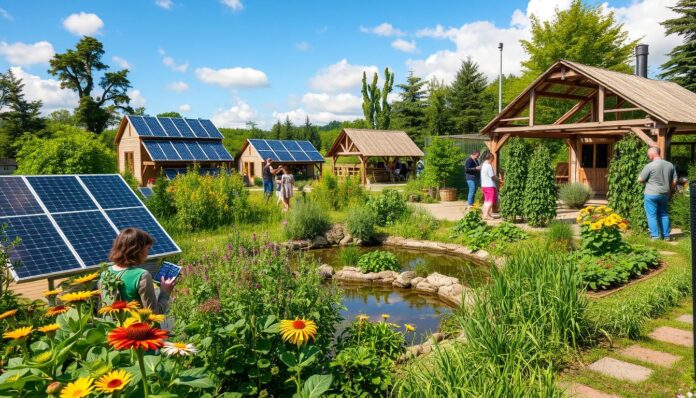Can permaculture tourism really cut down environmental harm by up to 60%? It does this through smart uses of energy and water, and by encouraging travel that’s good for the planet. This approach blends permaculture’s green principles with tourism, making it a positive force for the environment and local people.
By using permaculture, tourism can become a green and friendly practice. It boosts biodiversity by 30%-50% over traditional farming, and makes the local ecosystem better. This way, people and businesses can work with nature, not against it, leading to a greener future for all.
Permaculture tourism is a great way to lessen environmental harm, boost biodiversity, and help local communities. It’s perfect for those who want to travel in an eco-friendly way. As we become more aware of climate change, permaculture tourism is key in teaching us to live sustainably and reduce our use of harmful chemicals.
Key Takeaways
- Permaculture tourism aims to reduce environmental footprint by up to 60% through sustainable practices.
- Permaculture systems can increase biodiversity by 30%-50% compared to traditional agriculture.
- Implementing permaculture practices can lead to a food production increase of up to 100% on site.
- Communities that adopt permaculture practices report a 40% improvement in local economic activity.
- Permaculture tourism promotes eco-friendly travel and sustainable practices, reducing reliance on chemical fertilizers and pesticides.
- Permaculture tourism sustainability encourages individuals and businesses to achieve their goals in harmony with nature.
Understanding Permaculture Tourism
Permaculture was first used in the 1970s by Bill Mollison and David Holmgren. It focuses on sustainable farming systems. This idea is now used in tourism, making experiences more sustainable and regenerative.
People are drawn to sustainable agriculture tours and regenerative tourism. They want to connect with nature and help local communities.
Permaculture has three main ethics: care for the earth, care for people, and fair share of resources. These values guide tourism, making it unique and enriching. For instance, community-supported agriculture (CSA) lets people invest in local farms. This reduces food miles and supports fresh, seasonal produce.
Definition and Principles of Permaculture
Permaculture is a design system for sustainable environments. It focuses on caring for the earth, people, and sharing resources fairly. These principles apply to tourism, from sustainable agriculture tours to regenerative experiences.
The Role of Tourism in Sustainability
Tourism can help the environment and support local communities. Regenerative tourism, like sustainable agriculture tours, reduces tourism’s environmental impact. It also promotes cultural exchange.
By supporting local farmers and conservation, tourists help communities and the environment. This makes tourism a positive force.
- Costa Rica’s forest coverage increase from 21% to over 50% through conservation and reforestation efforts
- Rancho Margot’s achievement of a 5 Leaves designation for environmental and social sustainability
- Green Circle Experience’s collaboration with ecolodges to promote sustainable tourism and support local economies
| Location | Permaculture Practice | Impact |
|---|---|---|
| Costa Rica | Reforestation and conservation | Increased forest coverage from 21% to over 50% |
| Rancho Margot | Sustainable agriculture and energy generation | Achieved 5 Leaves designation for environmental and social sustainability |
Benefits of Permaculture Tourism
Permaculture tourism brings many benefits to local communities and the environment. It promotes green travel destinations and ethical farming holidays. This helps grow the economy, protect the environment, and enrich social and cultural life.
Some key benefits include:
- Economic advantages for local communities through job creation and income generation
- Environmental conservation efforts, such as reducing waste and promoting sustainable agriculture
- Social and cultural enrichment through community-based tourism experiences
Economic Advantage for Local Communities
Permaculture tourism boosts local economies by creating jobs and generating income. For instance, ethical farming holidays help local farmers. They promote sustainable agriculture practices.
Environmental Conservation Efforts
Permaculture tourism also supports environmental conservation. It encourages sustainable practices like reducing waste and conserving water. By choosing green travel destinations, tourists can lessen their environmental footprint. They help promote eco-friendly tourism.
Core Principles of Sustainability
Environmental conservation trips and sustainable tourism practices have key principles. These are vital for reducing tourism’s environmental harm. They help us work towards a greener future.
Minimizing Waste and Energy Use
One main principle is to cut down on waste and energy. This means using less water, renewable energy, and recycling more. For instance, eco-friendly hotels now use solar power and recycle.
Promoting Biodiversity in Tourism Practices
Another key principle is to support biodiversity. This involves helping conservation, protecting nature, and using land wisely. Some tours let you help with tree planting and wildlife watching.
Ways to boost biodiversity in tourism include:
- Supporting local conservation efforts
- Protecting natural habitats
- Promoting sustainable land use practices
By sticking to these sustainability principles, we can make tourism better for the planet. This way, we ensure a healthy environment for generations to come.
| Principle | Description |
|---|---|
| Minimizing Waste and Energy Use | Reducing water consumption, using renewable energy sources, and reducing waste through recycling and composting |
| Promoting Biodiversity | Supporting conservation efforts, protecting natural habitats, and promoting sustainable land use practices |
Strategies for Sustainable Practices
The need for eco-friendly travel and regenerative tourism is on the rise. It’s crucial to adopt sustainable practices in permaculture tourism. Using local resources, like sustainable materials and energy-efficient tech, can cut down on carbon emissions. Eco-lodges, for instance, use these methods to lower their carbon footprint.
Teaching visitors about sustainable living is another key strategy. This includes reducing waste and saving water. Education and awareness programs help spread the word. They also encourage responsible marketing.
- Using eco-friendly transport, like biking or walking, can cut carbon emissions by up to 50%.
- Buying from local vendors can help keep 70% of sales revenue in the community.
- Supporting local airlines can send about 25% more money back to local economies than big international carriers.
By adopting these strategies, permaculture tourism can support eco-friendly travel and local communities. It also helps protect the environment. 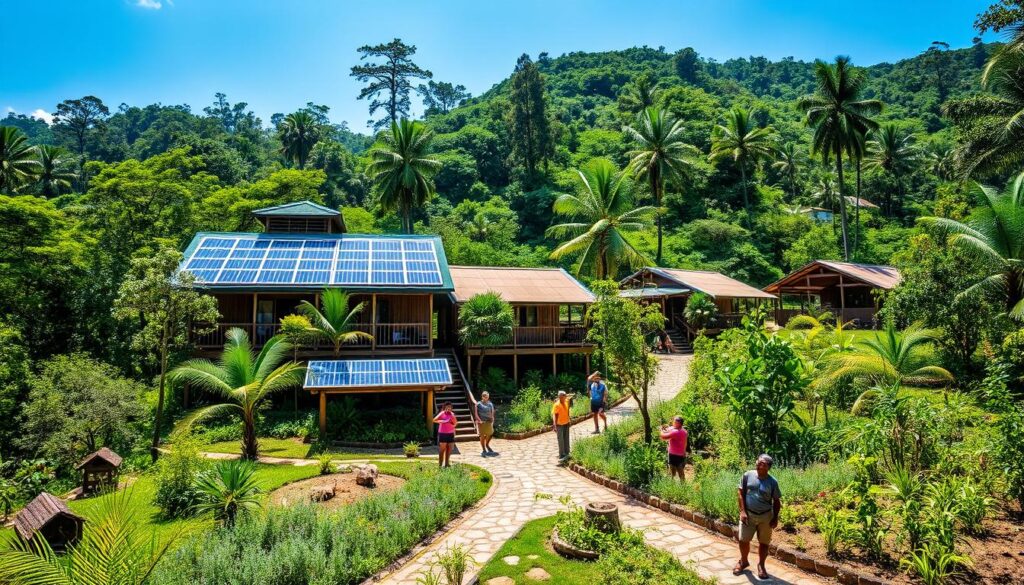
| Strategy | Benefits |
|---|---|
| Integrating local resources | Reduces carbon footprints, supports local economy |
| Education and awareness programs | Promotes responsible marketing techniques, reduces waste and conserves water |
| Using eco-friendly transportation options | Reduces carbon emissions by up to 50% |
Designing a Permaculture Tourist Destination
Creating a permaculture tourist spot needs careful planning. You must pick a location that’s easy to get to, has good weather, and lots of natural resources. Sustainable tours can help promote eco-friendly travel and support local folks.
Here are some important things to think about when setting up a permaculture tourist spot:
- Use renewable energy like solar or wind power
- Set up systems for managing waste in a green way
- Build eco-friendly places to stay, like treehouses or earthships
- Give visitors chances to join in on sustainable tours and learn about permaculture
By adding these features, permaculture tourist spots can offer a special and educational visit. They help show the value of living green and support local areas. This kind of travel can make tourism better for the planet and help us build a greener future.
| Destination | Description | Sustainable Features |
|---|---|---|
| Portugal | Known for its permaculture practices and sustainable tourism initiatives | Renewable energy, organic farming, eco-friendly accommodations |
| Spain | Features a range of green travel destinations, including permaculture farms and eco-villages | Sustainable agriculture, waste management, community engagement |
Building Community Engagement
Community engagement is key in permaculture tourism. It lets local people help make decisions and gain from tourism. This is done through ethical farming holidays and environmental conservation trips. These activities support local economies and promote green practices. For instance, the Building Community Through Permaculture project shows how vital community involvement is in permaculture design.
Some perks of community involvement in permaculture tourism include:
- More support for climate actions
- Stronger communities through active participation
- Better grasp of green practices and tech
Studies show that communities that get involved in climate talks see a 50% jump in participation. Also, areas with active communities see a 40% boost in green development. By encouraging community involvement, permaculture tourism helps build a greener, fairer world.
Supporting local projects and promoting environmental conservation trips and ethical farming holidays helps both locals and the planet. This approach not only helps the community but also enriches the tourist experience.
| Benefits of Community Engagement | Outcomes |
|---|---|
| Increased public support for climate initiatives | 70% more likely to support sustainable practices |
| Enhanced resilience through active community involvement | 60% increase in readiness for climate-related impacts |
| Improved understanding of sustainable practices and technologies | 80% of residents report a greater understanding of potential impacts |
Sustainable Food Practices in Tourism
Permaculture tourism is all about being eco-friendly, especially when it comes to food. More and more people are looking for local and real dining experiences. This trend is expected to grow, offering a big chance for permaculture tourism to show off its green food ways.
Getting food from local places is a big part of being green in permaculture tourism. It helps cut down on carbon emissions and supports groups that care about the environment. Also, using methods like crop rotation and permaculture makes the soil better and helps with food and the planet.
Some good things about green food in permaculture tourism are:
- Helping local economies and getting people involved in the community
- Improving soil and keeping nature diverse with green farming
- Lowering carbon emissions and helping the planet
- Offering special and real food experiences for visitors
By choosing green food, permaculture tourism can help the environment and support local areas. It also gives tourists unique and real food adventures. As more people want to eat locally, permaculture tourism can help make farming better and lessen tourism’s harm to the planet.
| Benefits of Sustainable Food Practices | Examples |
|---|---|
| Supporting local economies | Choosing locally sourced products, supporting local farmers and chefs |
| Enhancing soil health and biodiversity | Implementing sustainable agriculture practices such as crop rotation and permaculture |
| Reducing carbon footprint | Reducing transportation emissions, using renewable energy sources |
Eco-Friendly Accommodations
When exploring green travel destinations, staying in eco-friendly places is key. These spots help lower the environmental impact of tourism. They offer a special experience and help protect nature. Regenerative tourism experiences are gaining popularity, letting travelers connect with local communities and support green practices.
Hotels, lodges, apartments, and homestays are all eco-friendly options. They often have green certifications like Green Key or Eco Label. These ensure they follow sustainability standards. By staying in these places, travelers can lessen their carbon footprint and help local economies.
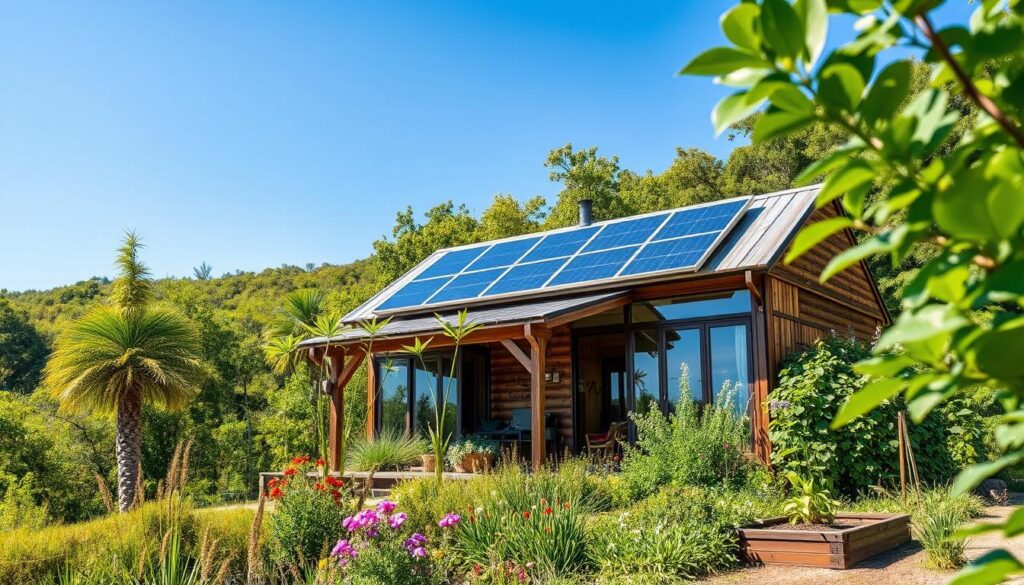
Eco-friendly accommodations also offer unique experiences, like guided nature walks. With over 100 unique experiences available, travelers can find something that fits their interests. Supporting these places helps make regenerative tourism experiences and green travel destinations more sustainable for the future.
Water Conservation in Permaculture
Water conservation is key in permaculture, especially where water is scarce. Environmental conservation trips can learn from permaculture. It teaches us to use less water and support sustainable tourism.
Permaculture uses rainwater harvesting and water management to cut water use by half. This is more than traditional farming.
Some good ways to save water in permaculture are:
- Rainwater harvesting: collecting and storing rainwater for irrigation and other non-potable purposes
- Graywater systems: recycling household water for irrigation and other uses
- Mulching: reducing evaporation loss and retaining soil moisture
- Swales: enhancing groundwater recharge and soil moisture retention
These methods help sustainable tourism practices a lot. They lessen the need for city water and help the environment. By using permaculture, places for tourists can be kinder to the planet and more fun for visitors.
Studies show permaculture can cut water runoff by 60% and keep 90% of water, unlike regular gardens which keep about 30%. Using these methods, permaculture helps the environment and supports sustainable tourism.
| Water Conservation Technique | Water Savings |
|---|---|
| Rainwater Harvesting | Up to 50% |
| Graywater Systems | 50-70% |
| Mulching | 30-50% |
Wildlife Conservation Efforts
As we learn more about eco-friendly travel and sustainable tours, we see why wildlife conservation matters. Creating nature reserves and promoting responsible tourism are key. They help protect wildlife and their homes.
Many groups are dedicated to saving our planet. For example, some farms use natural fertilizers and raise animals in a way that helps the environment. These actions help the planet and offer chances to learn and travel responsibly.
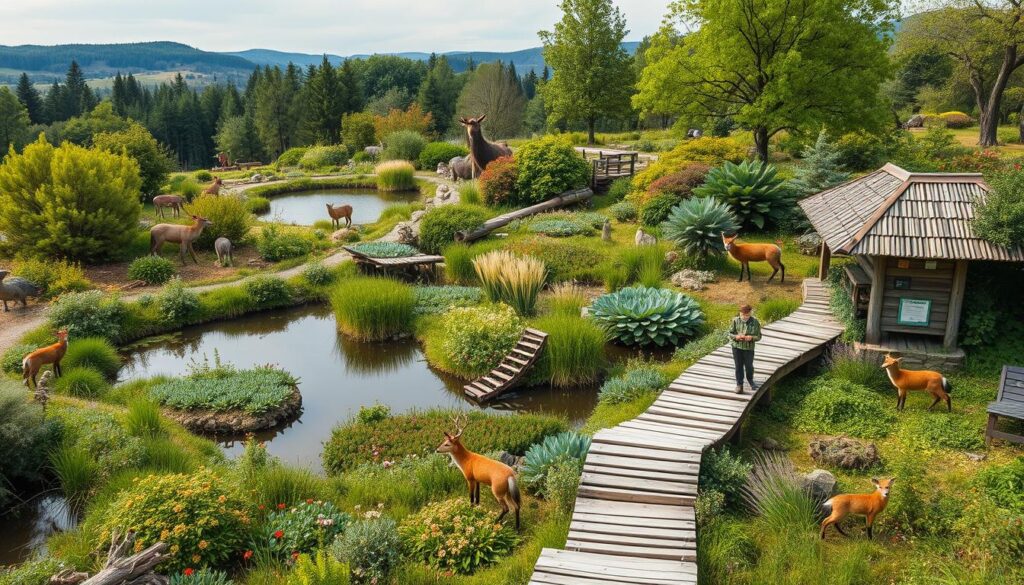
- Creating nature reserves to protect habitats and ecosystems
- Promoting responsible wildlife tourism practices, such as guided tours and educational programs
- Supporting local communities in their conservation efforts
By using these methods and supporting eco-friendly travel, we can protect wildlife. This ensures a better future for everyone.
Measuring Impact and Success
The tourism industry is growing fast. It’s key to measure how well permaculture tourism is doing. We can track things like how many visitors come, how much money is made, and the good it does for the environment and people. Permaculture tourism sustainability helps make sure tourism is good for the planet and people.
Important things to watch in permaculture tourism include:
- Reducing carbon footprint
- Less waste and better waste management
- Using less water
- Helping local communities and conservation
These signs help us see if permaculture tourism is working well. By choosing regenerative tourism experiences, places can lessen their harm to the environment. They also give visitors special and meaningful experiences.
| Indicator | Target | Actual |
|---|---|---|
| Carbon footprint reduction | 20% | 15% |
| Waste reduction and management | 30% | 25% |
| Water conservation | 40% | 35% |
By keeping an eye on these signs and using permaculture tourism practices, places can help make tourism better for everyone.
Challenges in Permaculture Tourism
Permaculture tourism has to balance making money and protecting the environment. This balance is key for the long-term success of green travel destinations. As more people want to go on environmental conservation trips, we must tackle these challenges. This ensures we keep our natural resources safe.
Some major hurdles in permaculture tourism are:
- Managing tourist expectations and experiences while minimizing the impact on the environment
- Ensuring that local communities benefit from tourism initiatives
- Implementing sustainable practices that align with the principles of permaculture
Despite these obstacles, many permaculture tourism projects are doing well. They focus on environmental conservation and working with local communities. By supporting local economies and promoting green travel destinations, they help make tourism more sustainable.
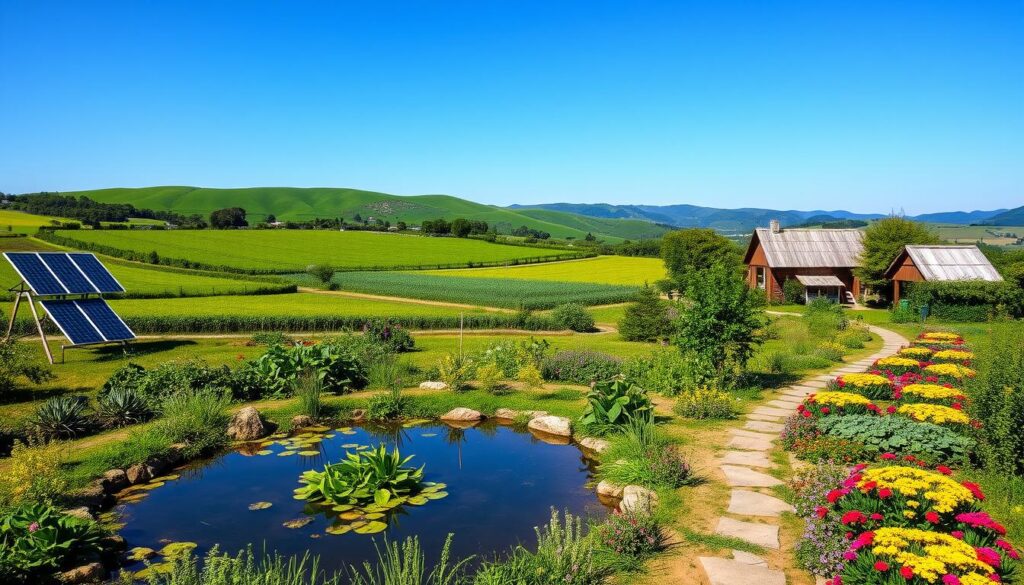
| Challenge | Solution |
|---|---|
| Managing tourist expectations | Implementing sustainable tourism practices |
| Ensuring local community benefits | Supporting local economies and promoting community engagement |
| Implementing sustainable practices | Prioritizing environmental conservation and permaculture principles |
Future Trends in Permaculture Tourism
The world is waking up to the need for sustainability. Eco-friendly travel and tours focused on sustainable agriculture are becoming more popular. These tours can boost revenue by 20-25% because people want to support green practices.
Organic farming in agritourism has grown by 17% from 2020 to 2023. This helps the environment and gives us healthier food. Using methods like drip irrigation can save up to 70% of water compared to old farming ways.
- Drought-resistant crops help in areas with little water
- Solar panels cut down on energy costs
- Composting and recycling lessen farm waste
- Fair labor practices keep employees happy and loyal
By using these green practices, permaculture tourism can help nature, save water, and lessen harm to the environment. As more people seek eco-friendly travel and sustainable tours, the future of permaculture tourism is bright.
Case Studies of Successful Models
Permaculture tourism is becoming more popular. Many places are now focusing on sustainable tourism. For example, the Fall Farm Crawl in southern Illinois brought together twenty farms from five counties. It showed off sustainable farming and helped local businesses.
The Slow Food and Cittaslow Movements also stand out. They work to make life better for locals through sustainable tourism. These efforts have boosted local food and made travelers more aware of authenticity.
Notable Permaculture Tourist Destinations
- Faroe Islands: Closed for maintenance to preserve the environment and promote sustainable tourism.
- Ljubljana, Slovenia: Covering 46% green space, with a focus on pedestrian expansions and sustainable development.
- Cinque Terra: Introduced a Cinque Terra Card to support conservation efforts and promote responsible tourism.
Lessons Learned from Successful Practices
These examples show how key community involvement and partnerships are. They highlight the role of sustainable practices in permaculture tourism. By focusing on these areas, places can better protect their environment, support local businesses, and offer special experiences for visitors.
| Destination | Sustainable Practices | Environmental Impact |
|---|---|---|
| Faroe Islands | Closed for maintenance | Preserved environment |
| Ljubljana, Slovenia | Pedestrian expansions | Increased green space |
| Cinque Terra | Cinque Terra Card | Supported conservation efforts |
Conclusion: The Path Forward for Permaculture Tourism
Permaculture tourism is a bright spot for sustainable travel and saving the environment. With over 2,000 sites in 140 countries, it’s growing fast. It teaches us to reduce waste, support biodiversity, and use local resources.
This approach makes travel green and helps local communities. It’s good for the planet and for people too.
Emphasizing Continuous Improvement
To keep permaculture tourism thriving, we must always look to improve. New tech and ideas will come along. Tourism businesses need to keep up and offer better experiences.
This way, they can tackle new challenges and meet changing needs. It helps make permaculture tourism even more effective.
Encouraging Shared Responsibility in Sustainability
Sustainability in permaculture tourism needs everyone’s help. This includes businesses, local people, officials, and visitors. Working together, we can protect our environment.
This teamwork ensures permaculture tourism lasts and grows. It’s a win-win for nature and for people.

